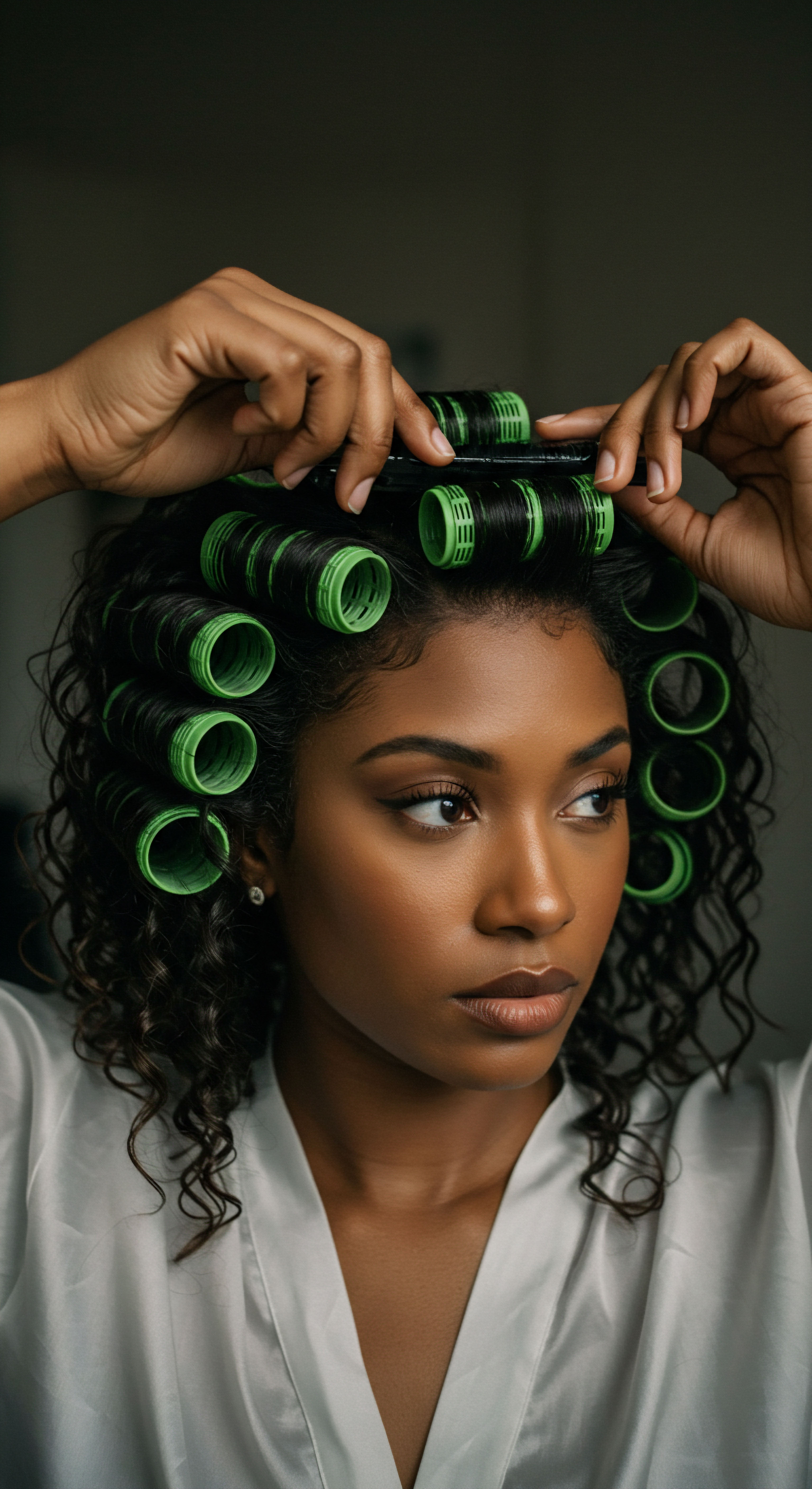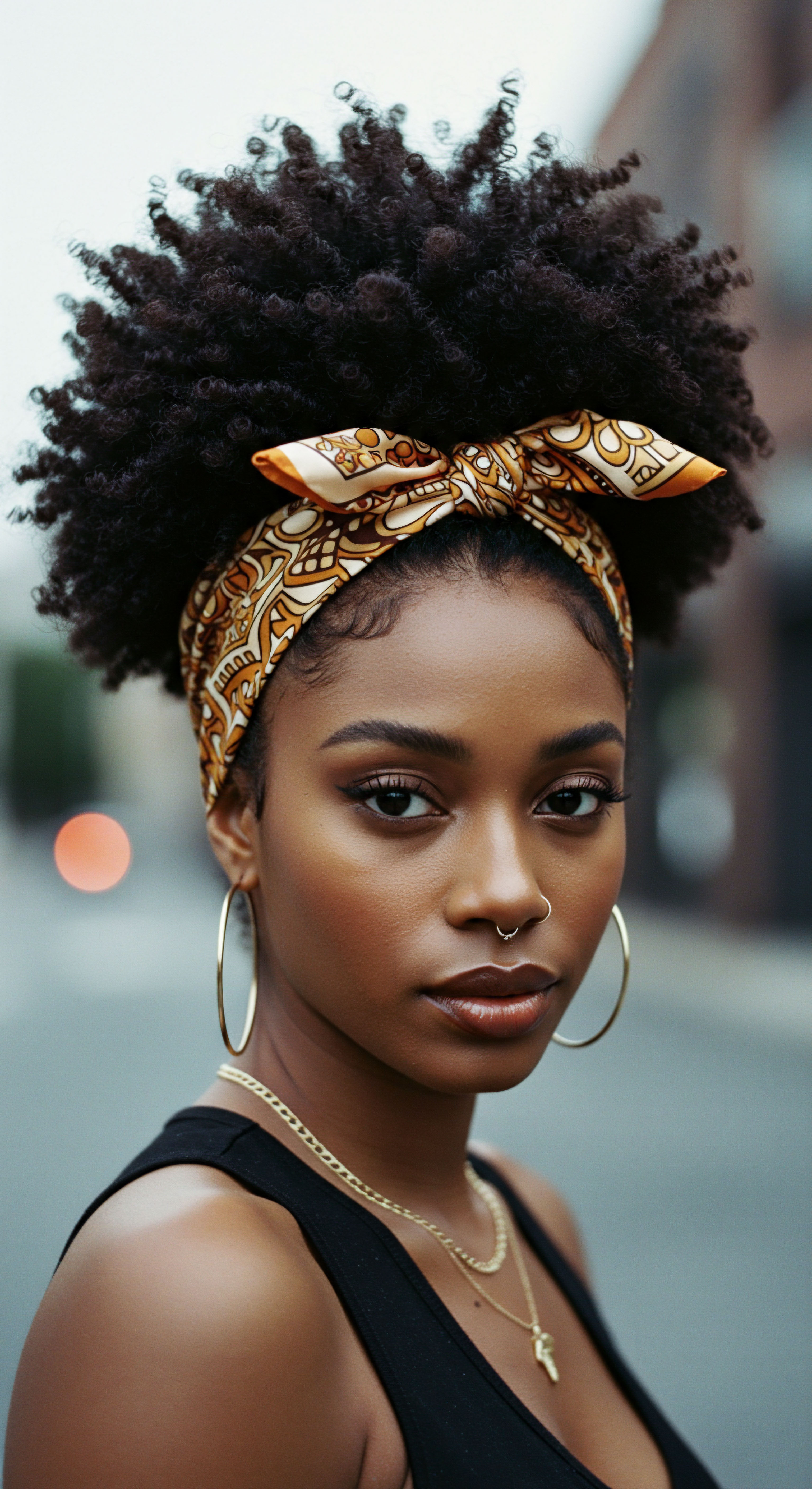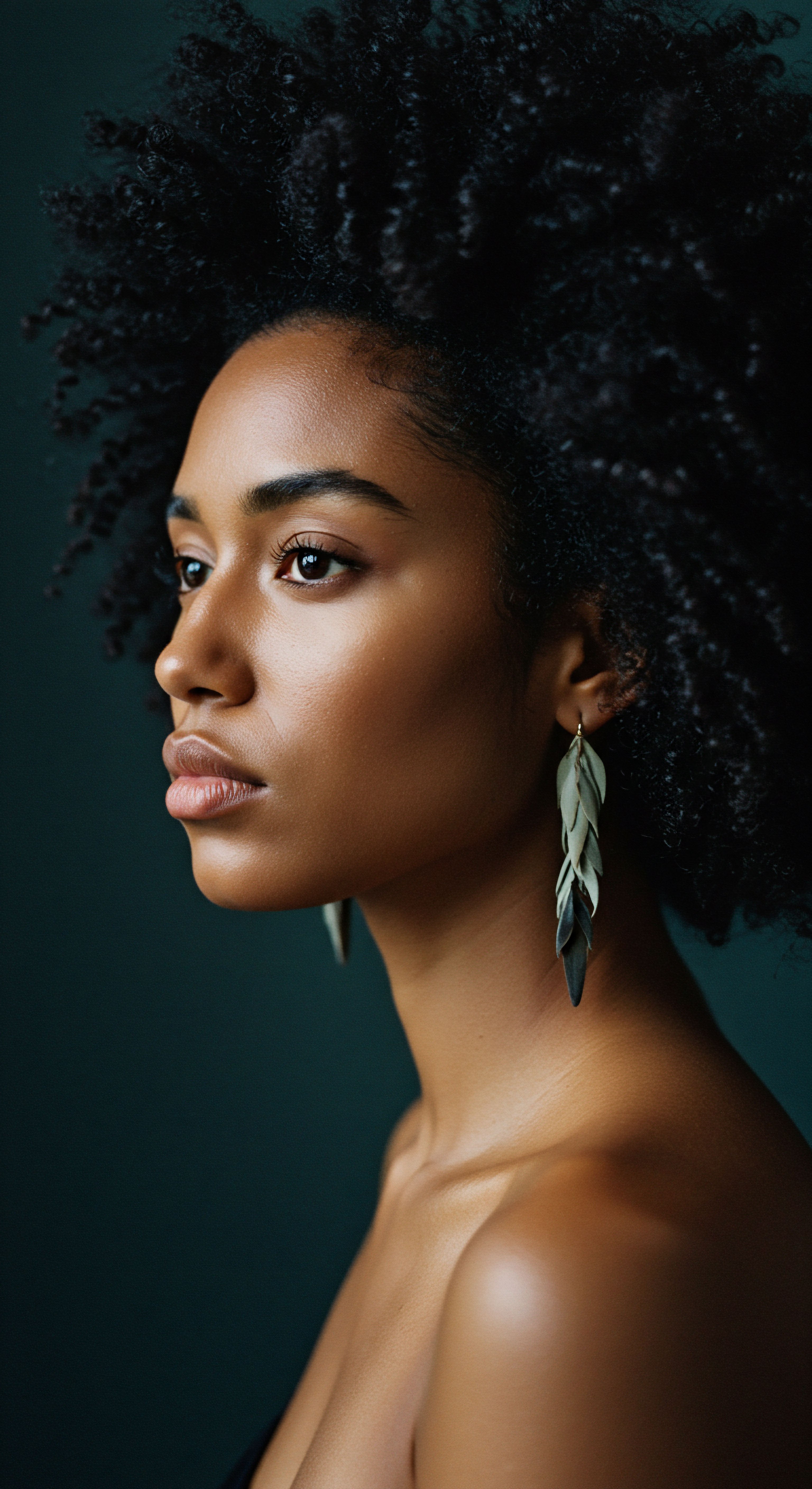
Roots
The story of Black hair care traditions is not a simple chronicle of styles and products; it is a profound journey through time, a testament to resilience, identity, and profound cultural connection. To truly appreciate the rich spectrum of Black hair today, we must first travel back, far beyond the modern salon, to a time when hair was a living canvas of social standing, spiritual belief, and community ties. This foundational exploration invites us to witness the origins of practices that, despite immense disruption, found ways to persist, adapt, and continually speak volumes.

Pre-Colonial Expressions
Before the cruel currents of the transatlantic slave trade altered destinies, hair in Africa served as a vibrant language. Each braid, each coil, each adornment held a specific meaning, acting as a visual code understood by all. Hairstyles conveyed a person’s Geographic Origin, their Marital Status, their Age, ethnic identity, religious affiliation, wealth, and social standing.
A person’s coiffure could reveal whether they were a warrior, a maiden, a grieving widow, or a revered elder. Among the Yoruba, for example, hair was held in sacred regard, considered the most elevated part of the body, with braided styles used to send messages to the gods.
The creation of these intricate styles was far from a solitary act. It was a deeply communal ritual, often spanning hours, even days. These sessions involved washing, combing, oiling, braiding, or twisting, and then adorning the hair with shells, beads, clay, or plant fibers.
Such gatherings were not merely about aesthetics; they served as vital social opportunities, reinforcing family bonds and community connections. This shared experience of care and beautification cemented cultural knowledge, passed down through generations.
In pre-colonial Africa, hair was a vibrant language, speaking volumes about identity, status, and spiritual connection within communities.
Consider the meticulousness of these practices:
- Braiding Patterns often identified an individual’s tribe or ethnic group.
- Adornments like cowrie shells, beads, or gold signified wealth or social standing.
- Specific Styles could mark rites of passage, such as a young woman’s transition to adulthood.
| Aspect of Identity Social Status |
| Hair's Role More elaborate styles indicated higher standing. |
| Aspect of Identity Marital Status |
| Hair's Role Certain braids or covered styles signaled marriage. |
| Aspect of Identity Ethnic Affiliation |
| Hair's Role Distinct patterns identified tribal origins. |
| Aspect of Identity Spiritual Beliefs |
| Hair's Role Hair served as a medium for connection to deities or ancestors. |

The Erasure and Persistence of Identity
The arrival of the transatlantic slave trade marked a brutal disruption of these deeply rooted traditions. Enslaved Africans were subjected to unimaginable cruelty, and among the first acts of dehumanization was the forced shaving of their heads. This act was deliberate, aimed at stripping individuals of their cultural identity and severing their connection to ancestral heritage. Without access to native tools, oils, or the time necessary for intricate care, hair often became matted, tangled, and damaged.
Despite these oppressive conditions, the spirit of self-expression and cultural continuity persisted. Enslaved people found ingenious ways to maintain aspects of their hair traditions, even if in modified forms. They used whatever limited resources were available, sometimes resorting to cooking grease like lard or butter for moisture, and even hot butter knives to curl their hair. Headwraps, initially worn out of necessity to protect neglected hair, became powerful symbols of quiet defiance and cultural continuity.
In some instances, braids were used as a secret messaging system, mapping escape routes from plantations, a remarkable act of resistance disguised in plain sight. This quiet persistence speaks volumes about the human need for identity, even under the most brutal forms of oppression.

Ritual
Stepping from the echoes of ancient traditions into the dawn of a new era, we begin to observe how the daily and periodic practices of hair care continued to shape lives. This segment explores the evolution of Black hair care through periods of immense societal shift, where ingenuity and enterprise transformed challenges into opportunities. It is a story of practical wisdom, of individuals rising to meet needs, and of the enduring significance of hair as a personal and collective statement. Here, techniques and methods are explored with gentle guidance, revealing the layers of care that emerged from necessity and grew into an industry.

From Necessity to Enterprise
The post-emancipation era presented a complex landscape for Black hair. While physical chains were broken, the psychological impact of slavery and the pervasive nature of Eurocentric beauty standards continued to exert influence. Straight hair was often perceived as a sign of respectability and a pathway to greater social and economic acceptance.
This societal pressure, rather than inherent preference, led to the widespread adoption of straightening methods. Early approaches involved crude hot combs and pressing irons, often causing damage to the scalp and hair.
It was against this backdrop that visionary Black women stepped forward, transforming the challenges of hair care into avenues of self-sufficiency and community building. Figures like Annie Turnbo Malone and Madam C.J. Walker stand as towering examples. Annie Malone, a chemist and entrepreneur, developed her line of non-damaging hair straighteners, special oils, and hair-stimulant products, including her famous “Wonderful Hair Grower.” She did not simply sell products; she built an educational empire.
In 1918, Malone established Poro College, the first Black-owned cosmetology school. This institution trained thousands of women in hair care, beauty, and business skills, providing crucial economic opportunities for Black women during the early 20th century.
Early Black hair care pioneers transformed the industry, not just by creating products, but by building educational and economic opportunities for Black women.
Madam C.J. Walker, a former sales agent for Malone, expanded upon these foundations. Recognizing the need for products that addressed hair loss and scalp conditions prevalent among Black women, she developed her own line of hair care solutions. Walker’s business model was revolutionary, employing thousands of Black women as door-to-door sales agents, known as “Walker Agents” or “hair culturists.” This network not only distributed products but also empowered women economically, providing a pathway to independence in an era where opportunities were severely limited.

What Methods Defined Early 20th Century Black Hair Care?
The early 20th century saw a consolidation of hair care practices aimed at achieving a straightened aesthetic, driven by societal pressures for assimilation.
- Hot Combs were a staple, heated on stoves and carefully passed through hair to temporarily straighten coils.
- Chemical Relaxers, often lye-based, began to appear, offering a more lasting alteration to hair texture. These early formulations were potent and often caused scalp burns.
- Greases and Pomades were used to add shine and manageability, though their formulations could be heavy and pore-clogging.
These methods, while providing a desired look, came with their own set of challenges. The pursuit of straight hair, a standard external to Black beauty, often resulted in damaged hair and scalp issues. Yet, within these constraints, a vibrant industry emerged, demonstrating incredible resilience and entrepreneurial spirit. The focus on hair health, even when manipulating texture, was a core tenet of these early pioneers.

Relay
As we move into a deeper examination of Black hair care traditions, we uncover a rich interplay of scientific understanding, cultural resurgence, and the enduring quest for self-definition. This section invites a profound insight into the complexities that shaped modern practices, moving beyond surface-level discussions to reveal the interconnectedness of biological realities, societal expectations, and collective identity. We will explore how scientific inquiry has illuminated the unique properties of textured hair, how cultural movements championed natural beauty, and how the echoes of historical pressures continue to resonate, even with new understandings.

The Resurgence of Natural Beauty
The mid-20th century witnessed a powerful cultural awakening that significantly reshaped the landscape of Black hair ❉ the Civil Rights Movement and the subsequent “Black is Beautiful” movement. This period marked a profound shift away from Eurocentric beauty standards, asserting the inherent beauty of Black features, including diverse skin tones, facial characteristics, and hair textures. The Afro hairstyle became a potent symbol of Black pride, activism, and defiance against societal norms that had long denigrated natural Black hair. Activists like Angela Davis proudly sported Afros, transforming hair into a political statement and a declaration of self-love and solidarity within the Black community.
This movement was not simply about a hairstyle; it was about reclaiming autonomy and celebrating a heritage that had been systematically suppressed. It encouraged individuals to embrace their natural coils, kinks, and curls, fostering a sense of collective self-acceptance. The second wave of the natural hair movement, spurred by the advent of social media in the 2000s, further amplified this shift, providing platforms for Black women to share hair care journeys, tutorials, and build a global community around natural hair.

How Did Societal Pressure Shape Health Outcomes?
Despite the celebratory shift towards natural hair, the historical legacy of societal pressure to conform to straightened aesthetics continues to have tangible health consequences. For decades, chemical relaxers were a ubiquitous tool in Black hair care, often used from a young age to achieve a desired straightened look. These products, particularly those containing lye, were known to cause scalp burns and lesions, creating pathways for chemicals to enter the body.
A critical examination of this historical context reveals a concerning intersection of beauty standards and public health. Research has begun to illuminate potential links between the prolonged use of chemical hair relaxers and various health issues disproportionately affecting Black women. For instance, a 2012 study published in the American Journal of Epidemiology, drawing data from the Black Women’s Health Study, found an association between hair relaxer use and an increased risk of uterine leiomyomata, commonly known as uterine fibroids. This study followed over 23,000 premenopausal Black American women from 1997 to 2009, observing that those who used relaxers had a 17% higher incidence of uterine fibroids compared to those who never used them.
More recent findings have further corroborated these concerns, with studies indicating that Black women are two to three times more likely to develop uterine fibroids than women of other racial groups, often at younger ages and with more severe symptoms. This suggests that decades of conforming to a beauty standard that necessitated chemical alteration may have contributed to a silent epidemic of reproductive health issues within the Black community.
This connection underscores a complex reality ❉ while hair care traditions represent cultural pride and personal expression, the historical pressure to alter natural textures for social acceptance has, for many, come at a significant cost to well-being. It is a powerful reminder that beauty standards are rarely benign; they are often deeply embedded with societal power structures, with health implications that ripple through generations.

The Role of Hair Science and Product Evolution
The scientific understanding of textured hair has grown significantly, moving away from outdated, often pathologizing views. Modern hair science recognizes the unique structural properties of coils and curls, such as their elliptical shape, fewer cuticle layers, and higher density of disulfide bonds, which contribute to their strength but also their propensity for dryness and tangling. This scientific understanding has spurred the development of specialized products that cater to the specific needs of textured hair, moving beyond a focus on straightening to one of health and definition.
The evolution of products reflects this journey. From early greases and lye-based relaxers, the market has shifted towards a vast array of conditioners, stylers, and treatments designed to nourish, moisturize, and protect natural textures. This change is not simply about new formulas; it represents a cultural embrace of diverse hair types and a rejection of the singular beauty ideal. The continued push for clean beauty and ingredient transparency in textured hair products also speaks to a community acutely aware of the historical health impacts of certain chemical exposures.
| Historical Period Pre-Colonial Africa |
| Primary Product Type Natural oils, herbs, clays |
| Underlying Goal Nourishment, adornment, cultural symbolism. |
| Historical Period Post-Slavery Era (Early 20th C.) |
| Primary Product Type Hot combs, greases, early chemical relaxers |
| Underlying Goal Straightening, assimilation, perceived respectability. |
| Historical Period Civil Rights Era (1960s-70s) |
| Primary Product Type Afro picks, minimal styling products |
| Underlying Goal Embracing natural texture, political statement. |
| Historical Period Modern Natural Hair Movement (2000s-Present) |
| Primary Product Type Moisturizing conditioners, curl definers, protective style products |
| Underlying Goal Health, definition, diverse styling, informed ingredient choices. |
| Historical Period This table illustrates a broad shift from alteration for assimilation to celebration of inherent texture. |

Reflection
The ongoing story of Black hair care traditions stands as a vibrant testament to enduring spirit, profound cultural connection, and unwavering self-definition. From the communicative artistry of ancestral coiffures to the modern digital spaces that celebrate every curl and coil, this journey reflects more than just changing styles. It speaks to the deep resilience of a people, their capacity to reclaim identity in the face of oppression, and their continued shaping of beauty ideals on their own terms. The hair itself becomes a living chronicle, each strand holding whispers of the past, vibrant expressions of the present, and limitless possibilities for the future.

References
- Byrd, Ayana, and Tharps, Lori. Hair Story ❉ Untangling the Roots of Black Hair in America. St. Martin’s Publishing, 2001.
- Giddings, Paula. Ida ❉ A Sword Among Lions ❉ Ida B. Wells and the Campaign Against Lynching. Amistad, 2008.
- Patton, Tracey Owens. “Hey Girl, Am I More Than My Hair?” Communication Quarterly, vol. 59, no. 4, 2011, pp. 434-453.
- Tharps, Lori L. Hair Story ❉ Untangling the Roots of Black Hair in America. St. Martin’s Press, 2001.
- Wise, Lauren A. et al. “Hair Relaxer Use and Risk of Uterine Leiomyomata in African-American Women.” American Journal of Epidemiology, vol. 175, no. 5, 2012, pp. 432-440.
- Walker, A’Lelia Bundles. On Her Own Ground ❉ The Life and Times of Madam C.J. Walker. Scribner, 2001.
- White, Whitney. The Curly Girl Handbook ❉ A Guide to Loving Your Natural Hair. Self-published, 2018.
- Hooks, Bell. Black Looks ❉ Race and Representation. South End Press, 1992.
- Davis, Angela Y. Women, Race, and Class. Vintage Books, 1981.
- Collins, Patricia Hill. Black Feminist Thought ❉ Knowledge, Consciousness, and the Politics of Empowerment. Routledge, 2000.